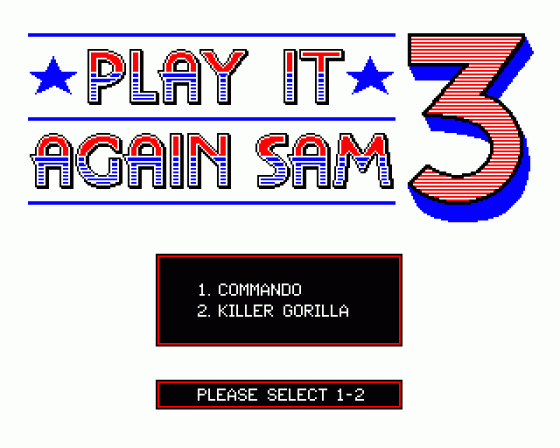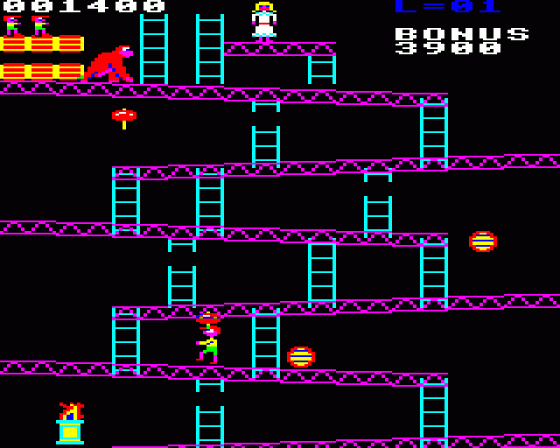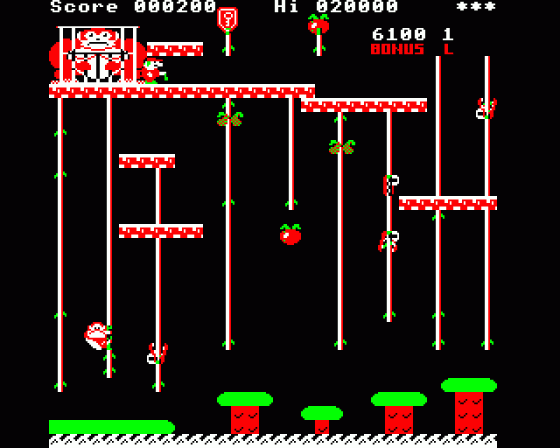
The Micro User
 1st January 1989
1st January 1989
Categories: Review: Software
Author: Hac Man
Publisher: Superior/Acornsoft
Machine: BBC B/B+/Master 128
Published in The Micro User 6.11
More great games
Sam 3 includes two games that did not originate from the Superior stable: Elite's Commando and Micro Power's Killer Gorilla.
Commando
Commando is the officially licensed home computer version of the arcade-machine game of the same name.
For the information of anyone who has not ventured into an amusement arcade in the last few years, or who missed the game on its initial release for the BBC Micro. Commando is another of the one-man-against-the-odds combat games that have become so popular in recent years.
You are Super Joe, the commando of the title. Armed only with a submachine gun and half a dozen grenades, you must penetrate the enemy defences and destroy the fortress. Easy to say, hard to accomplish.
Like Tynesoft's Saigon, Commando features a number of different screens. Once you have fought your way from the bottom of one to the top, it scrolls vertically down to reveal a new screenful of hazards.
This re-released Commando incorporates one key improvement on the original: When playing that you sometimes could not determine from the screen display when you had been killed. Now there is no doubt: A blinding white flash heralds your call-up to the ranks of the ex-commandos.
I have never been particularly impressed by theBBC Micro version of Commando. Its main drawback is that it comes off very badly from the dilemma that faces every BBC Micro programmer - weighing up the pros and cons of each screen mode and the conflicting features of screen resolution, screen size and available number of colours.
Commando runs in Mode 5, which allows only four colours on screen and I found that many graphic features tended to merge into one another.
Although I get the impression that battlefields are pretty drab places, with the same four colours Saigon seems to generate an impression of far greater vibrancy than does Commando. Nevertheless, if you're a fan of shoot-anything-that-moves games, you could do worse than Commando.
Killer Gorilla
Killer Gorilla will need little introduction to the majority of BBC Micro owners. It is an excellent implementation of the ever-popular arcade machine game Donkey Kong. Although released in the relatively early days of the BBC Micro, I have never seen another version that surpasses it in quality and playability. When an officially licensed version did the rounds of the popular home computers a few years ago, I was interested to see that no BBC Micro version ever appeared: Killer Gorilla got it right first time.
You play Mario, a humble carpenter. The evil Kong has carried off your girlfriend, to the top of an unsteady tower of scaffolding. You have to climb the tower to rescue her.
The game features four screens, each more difficult than the last. The first is a straight climb from the bottom to the top and the second introduces conveyer belts that keep changing direction. The third features lifts, made up of pieces of girder, and bouncing girders that can quickly cut down an inattentive carpenter.
The final screen looks perfectly straightforward, but is rapidly overrun with deadly fireballs. However, it also includes two hammers and, if you can reach them in time they will make short work of your fiery adversaries.
After you have completed this level and defeated the gorilla, you return to the first screen to find that things have changed, for the worse.
There are now gaps in the framework of the girders - so jump for your life. The conveyers on screen two move more quickly than before, as do the lifts on screen three. In all, the game has 15 increasingly difficult levels - enough to test even the most ardent hero.
Killer Gorilla 2 is a BBC Micro version of the arcade follow-up, Donkey Kong Junior. Older games players may remember the original release under the name of Zany Kong Junior.
Unfortunately that had to be withdrawn for copyright reasons
In Killer Gorilla 2, the roles have been completely reversed: Mario - now called Morris - has defeated Kong and rescued his girlfriend. However, in an act of revenge he has captured Kong and you - Kong Junior - must rescue your elder.
The game features four different screens that repeat with increased difficulty. However, unlike the first Killer Gorilla, the four screens do not follow a consistent theme.
The first requires you to swing around a network of vines bridged by brick platforms. Unfortunately, as usual, the screen is far from deserted.
The second level is completely different. The only way to reach the trailing chains way out of reach above your head is to bounce on a spring just in front of you.
The third screen depicts the generator room where you must scramble along electrical cables, avoiding the high voltage sparks that race around the circuit. This can be very difficult because so many sparks are speeding in different directions that even a small gorilla cannot evade them for long.
When you finally reach the fourth level you look up to see Kong Senior's cage sitting on a girder held in place by six ropes high above your head. Six keys are attached to the chains hanging from the girder - collect them all to release your parent.
However, you must now contend with both the snapping heads from the first screen and the giant parrots from the second. As in Killer Gorilla 1, once you have completed this you are returned to screen one with increased difficulty and must perform your feats of heroism all over again.
Palace Of Magic
The last title in the collection is Palace Of Magic, one of my good lady's all-time favourite games. It is an arcade adventure with more than 100 screens, very similar in appearance to Superior's classic Citadel.
Palace Of Magic does not attempt to disguise the source of its inspiration - quite the reverse in fact: You have offended the evil wizard Caldeti - try rearranging the letters! - who has shrunk you tothe size of a dwarf and imprisoned you in the Palace of Magic.
The complete map is very large and the solution to a particular problem often lies at the opposite extreme to the problem itself, so it's essential to draw a map and plan ahead.
One detail that caused minor problems on the game's initial release is that the screen goes black when you venture down a certain ladder - you've entered the palace dungeons. Don't be put off!
If you like games that require a combination of logical thought and manual dexterity, then Palace of Magic will certainly provide a considerable test to both skills.
Other Reviews Of Play It Again Sam 3 For The BBC B/B+/Master 128
Play It Again Sam 3 (Superior/Acornsoft)
A review by Dave Reeder (A&B Computing)
Play It Again Sam 3 (Superior/Acornsoft)
A review by Russell Wills (Too Big Issue)
Scores
BBC B/B+/Master 128 Version| Sound | 9 |
| Graphics | 9 |
| Playability | 9 |
| Value for Money | 9 |
| Overall | 9 |

















